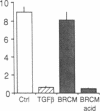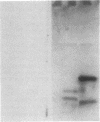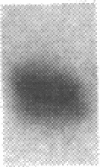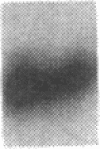Abstract
Transforming growth factor-beta (TGF beta) promotes deposition of extracellular matrix and is associated with fibrotic conditions both in experimental animals and in humans. Although a role for mast cells has been suspected in the pathogenesis of fibrosis, no potent mediator capable of stimulating fibroblast growth or extracellular matrix deposition has been identified in mast cell supernatants. We report here the constitutive production of TGF beta 1 by four dog mastocytoma cell lines. TGF beta 1 was identified by characteristic biologic activity, blockade of biologic effect by specific neutralizing antibody, and by recognition of a band with the appropriate migration by western blot. TGF beta 1 mRNA, but not TGF beta 2 or TGF beta 3 mRNA, was also produced constitutively by all four cell lines. Quantitation by bioassay revealed baseline TGF beta secretion of approximately 1 ng/10(6) cells over 48 h. Stimulation of mastocytoma cells with phorbol ester increased the rate of release of TGF beta 1, most markedly in the first 30 min after stimulation, without increasing TGF beta 1 mRNA. Dog mastocytoma cells produced TGF beta 1 primarily in a latent form, inactive until treated with acid. Both pure TGF beta 1 and TGF beta-containing mastocytoma cell-conditioned media inhibited mitogenesis and proliferation in dog mastocytoma cell lines, suggesting that mast cell tumor lines would not grow preferentially based on their ability to produce TGF beta. These studies may make possible further investigation of the mechanism by which mast cells contribute to the induction of fibrosis.
Full text
PDF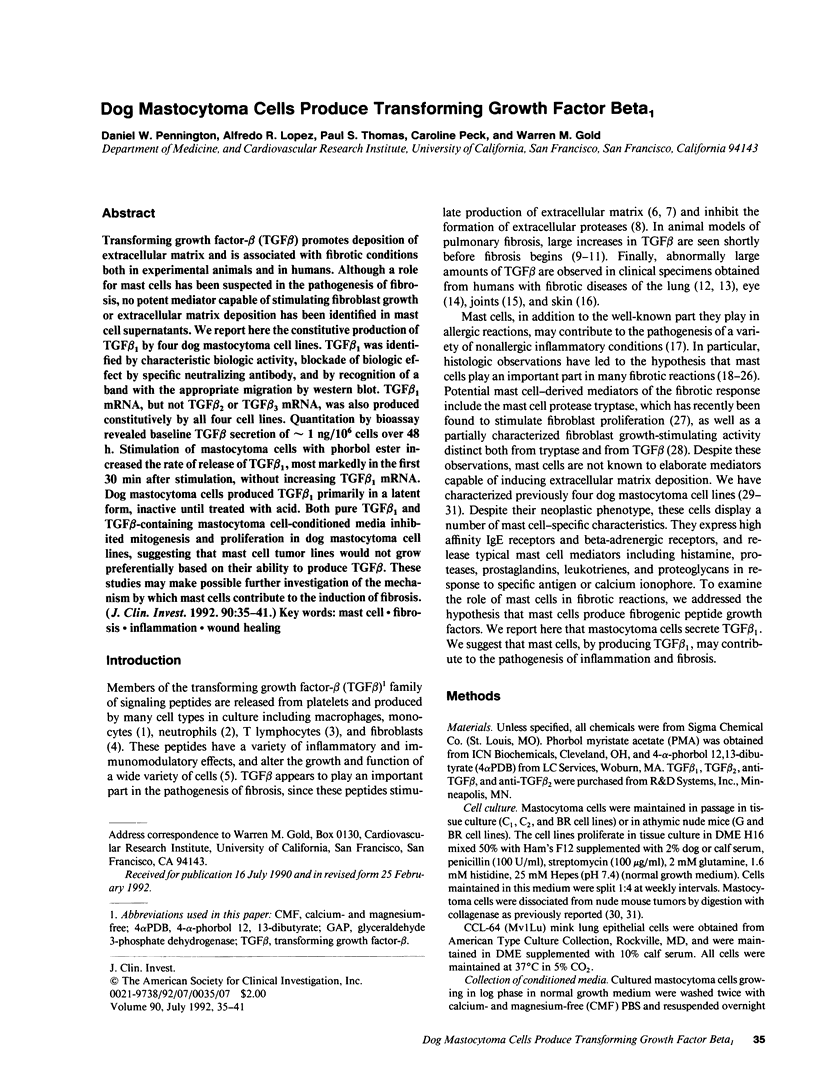
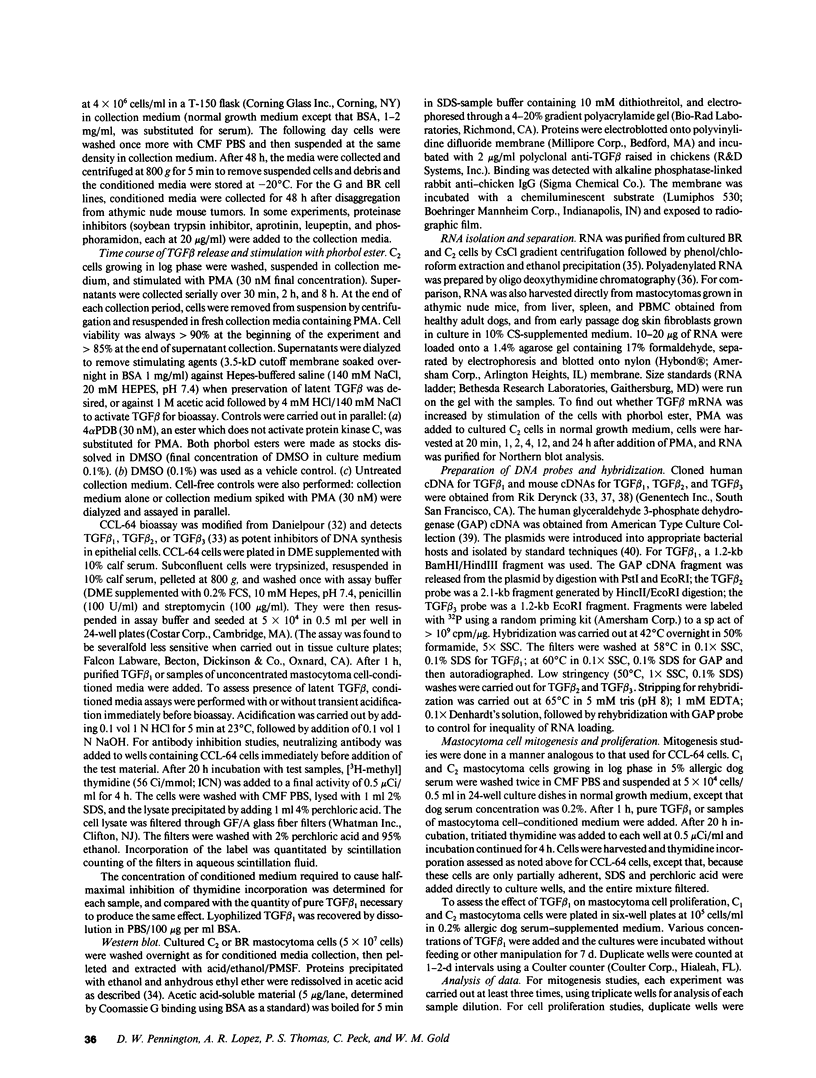
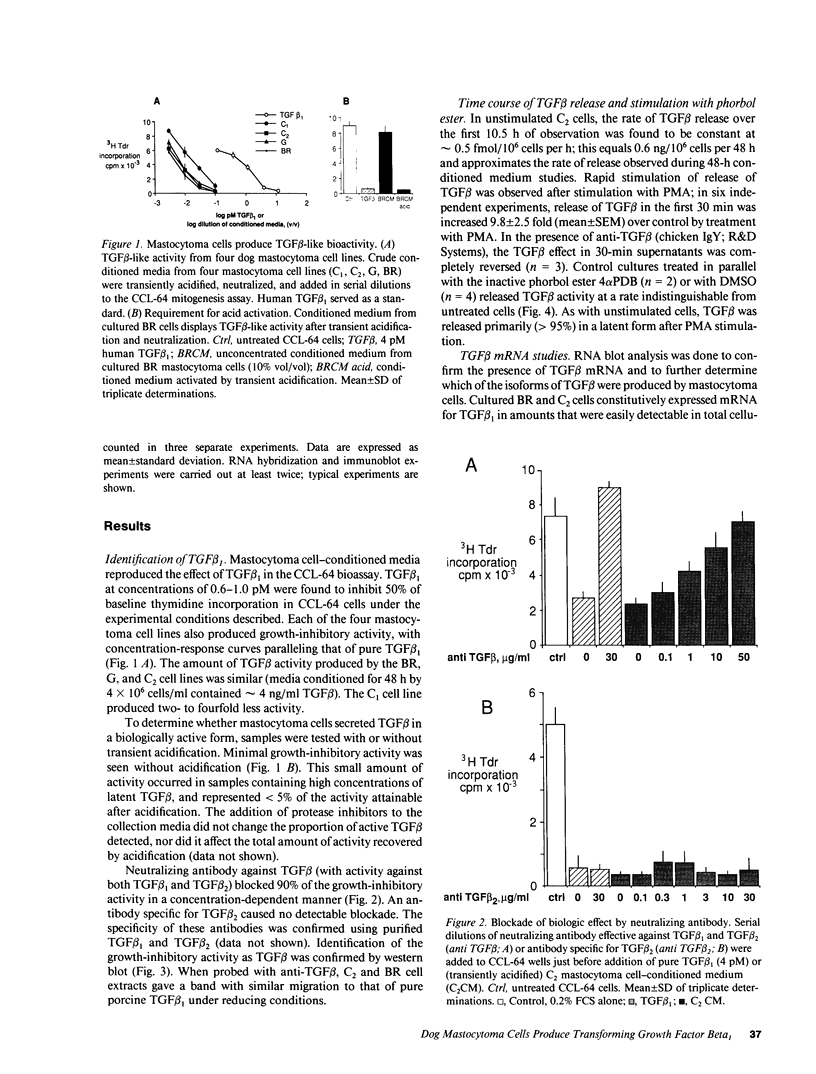
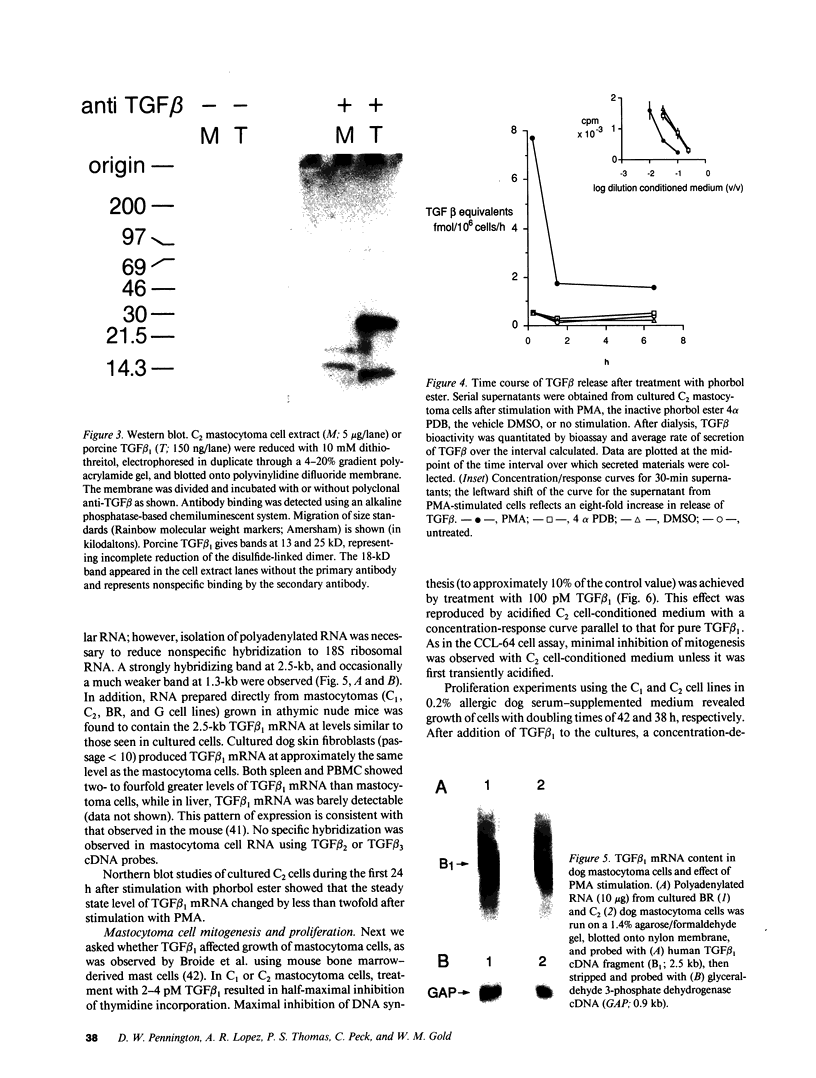
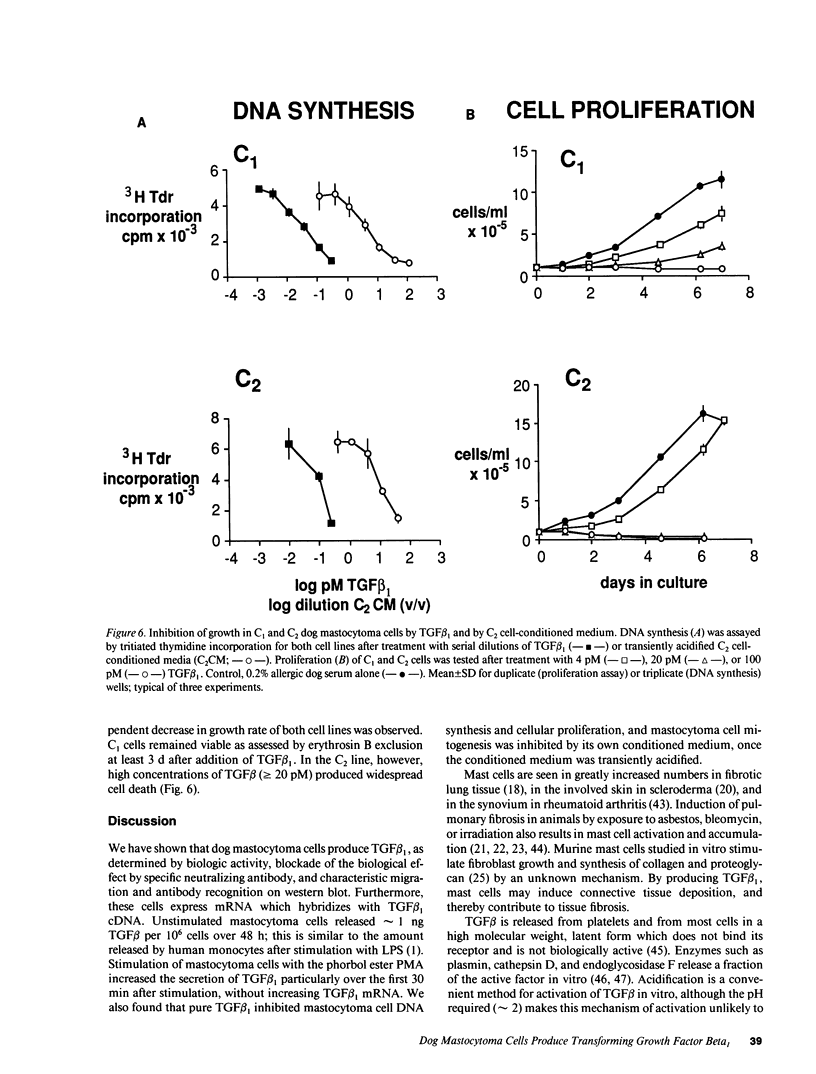
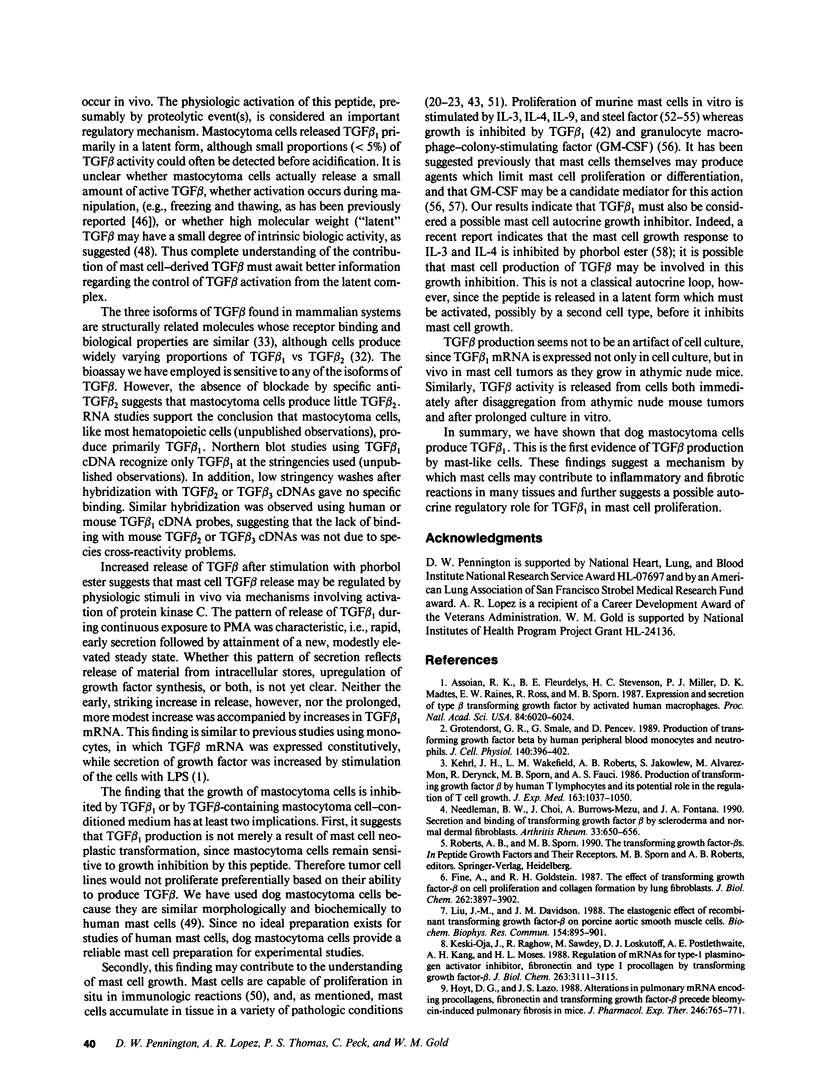

Images in this article
Selected References
These references are in PubMed. This may not be the complete list of references from this article.
- Anderson D. M., Lyman S. D., Baird A., Wignall J. M., Eisenman J., Rauch C., March C. J., Boswell H. S., Gimpel S. D., Cosman D. Molecular cloning of mast cell growth factor, a hematopoietin that is active in both membrane bound and soluble forms. Cell. 1990 Oct 5;63(1):235–243. doi: 10.1016/0092-8674(90)90304-w. [DOI] [PubMed] [Google Scholar]
- Assoian R. K., Fleurdelys B. E., Stevenson H. C., Miller P. J., Madtes D. K., Raines E. W., Ross R., Sporn M. B. Expression and secretion of type beta transforming growth factor by activated human macrophages. Proc Natl Acad Sci U S A. 1987 Sep;84(17):6020–6024. doi: 10.1073/pnas.84.17.6020. [DOI] [PMC free article] [PubMed] [Google Scholar]
- Assoian R. K. Purification of type-beta transforming growth factor from human platelets. Methods Enzymol. 1987;146:153–163. doi: 10.1016/s0076-6879(87)46017-5. [DOI] [PubMed] [Google Scholar]
- Aviv H., Leder P. Purification of biologically active globin messenger RNA by chromatography on oligothymidylic acid-cellulose. Proc Natl Acad Sci U S A. 1972 Jun;69(6):1408–1412. doi: 10.1073/pnas.69.6.1408. [DOI] [PMC free article] [PubMed] [Google Scholar]
- Bienenstock J., Tomioka M., Stead R., Ernst P., Jordana M., Gauldie J., Dolovich J., Denburg J. Mast cell involvement in various inflammatory processes. Am Rev Respir Dis. 1987 Jun;135(6 Pt 2):S5–S8. doi: 10.1164/arrd.1987.135.6P2.S5. [DOI] [PubMed] [Google Scholar]
- Bressler R. B., Thompson H. L., Keffer J. M., Metcalfe D. D. Inhibition of the growth of IL-3-dependent mast cells from murine bone marrow by recombinant granulocyte macrophage-colony-stimulating factor. J Immunol. 1989 Jul 1;143(1):135–139. [PubMed] [Google Scholar]
- Broekelmann T. J., Limper A. H., Colby T. V., McDonald J. A. Transforming growth factor beta 1 is present at sites of extracellular matrix gene expression in human pulmonary fibrosis. Proc Natl Acad Sci U S A. 1991 Aug 1;88(15):6642–6646. doi: 10.1073/pnas.88.15.6642. [DOI] [PMC free article] [PubMed] [Google Scholar]
- Broide D. H., Wasserman S. I., Alvaro-Gracia J., Zvaifler N. J., Firestein G. S. Transforming growth factor-beta 1 selectively inhibits IL-3-dependent mast cell proliferation without affecting mast cell function or differentiation. J Immunol. 1989 Sep 1;143(5):1591–1597. [PubMed] [Google Scholar]
- Chaikin E., Ziltener H. J., Razin E. Protein kinase C plays an inhibitory role in interleukin 3- and interleukin 4-mediated mast cell proliferation. J Biol Chem. 1990 Dec 25;265(36):22109–22116. [PubMed] [Google Scholar]
- Chirgwin J. M., Przybyla A. E., MacDonald R. J., Rutter W. J. Isolation of biologically active ribonucleic acid from sources enriched in ribonuclease. Biochemistry. 1979 Nov 27;18(24):5294–5299. doi: 10.1021/bi00591a005. [DOI] [PubMed] [Google Scholar]
- Choi K. L., Giorno R., Claman H. N. Cutaneous mast cell depletion and recovery in murine graft-vs-host disease. J Immunol. 1987 Jun 15;138(12):4093–4101. [PubMed] [Google Scholar]
- Connor T. B., Jr, Roberts A. B., Sporn M. B., Danielpour D., Dart L. L., Michels R. G., de Bustros S., Enger C., Kato H., Lansing M. Correlation of fibrosis and transforming growth factor-beta type 2 levels in the eye. J Clin Invest. 1989 May;83(5):1661–1666. doi: 10.1172/JCI114065. [DOI] [PMC free article] [PubMed] [Google Scholar]
- Crisp A. J., Chapman C. M., Kirkham S. E., Schiller A. L., Krane S. M. Articular mastocytosis in rheumatoid arthritis. Arthritis Rheum. 1984 Aug;27(8):845–851. doi: 10.1002/art.1780270802. [DOI] [PubMed] [Google Scholar]
- Danielpour D., Dart L. L., Flanders K. C., Roberts A. B., Sporn M. B. Immunodetection and quantitation of the two forms of transforming growth factor-beta (TGF-beta 1 and TGF-beta 2) secreted by cells in culture. J Cell Physiol. 1989 Jan;138(1):79–86. doi: 10.1002/jcp.1041380112. [DOI] [PubMed] [Google Scholar]
- Dayton E. T., Caulfield J. P., Hein A., Austen K. F., Stevens R. L. Regulation of the growth rate of mouse fibroblasts by IL-3-activated mouse bone marrow-derived mast cells. J Immunol. 1989 Jun 15;142(12):4307–4313. [PubMed] [Google Scholar]
- DeVinney R., Gold W. M. Establishment of two dog mastocytoma cell lines in continuous culture. Am J Respir Cell Mol Biol. 1990 Nov;3(5):413–420. doi: 10.1165/ajrcmb/3.5.413. [DOI] [PubMed] [Google Scholar]
- Derynck R., Jarrett J. A., Chen E. Y., Eaton D. H., Bell J. R., Assoian R. K., Roberts A. B., Sporn M. B., Goeddel D. V. Human transforming growth factor-beta complementary DNA sequence and expression in normal and transformed cells. Nature. 1985 Aug 22;316(6030):701–705. doi: 10.1038/316701a0. [DOI] [PubMed] [Google Scholar]
- Dvorak A. M., Mihm M. C., Jr, Dvorak H. F. Morphology of delayed-type hypersensitivity reactions in man. II. Ultrastructural alterations affecting the microvasculature and the tissue mast cells. Lab Invest. 1976 Feb;34(2):179–191. [PubMed] [Google Scholar]
- Fava R., Olsen N., Keski-Oja J., Moses H., Pincus T. Active and latent forms of transforming growth factor beta activity in synovial effusions. J Exp Med. 1989 Jan 1;169(1):291–296. doi: 10.1084/jem.169.1.291. [DOI] [PMC free article] [PubMed] [Google Scholar]
- Fine A., Goldstein R. H. The effect of transforming growth factor-beta on cell proliferation and collagen formation by lung fibroblasts. J Biol Chem. 1987 Mar 15;262(8):3897–3902. [PubMed] [Google Scholar]
- Goto T., Befus D., Low R., Bienenstock J. Mast cell heterogeneity and hyperplasia in bleomycin-induced pulmonary fibrosis of rats. Am Rev Respir Dis. 1984 Nov;130(5):797–802. doi: 10.1164/arrd.1984.130.5.797. [DOI] [PubMed] [Google Scholar]
- Graycar J. L., Miller D. A., Arrick B. A., Lyons R. M., Moses H. L., Derynck R. Human transforming growth factor-beta 3: recombinant expression, purification, and biological activities in comparison with transforming growth factors-beta 1 and -beta 2. Mol Endocrinol. 1989 Dec;3(12):1977–1986. doi: 10.1210/mend-3-12-1977. [DOI] [PubMed] [Google Scholar]
- Grotendorst G. R., Smale G., Pencev D. Production of transforming growth factor beta by human peripheral blood monocytes and neutrophils. J Cell Physiol. 1989 Aug;140(2):396–402. doi: 10.1002/jcp.1041400226. [DOI] [PubMed] [Google Scholar]
- Hawkins R. A., Claman H. N., Clark R. A., Steigerwald J. C. Increased dermal mast cell populations in progressive systemic sclerosis: a link in chronic fibrosis? Ann Intern Med. 1985 Feb;102(2):182–186. doi: 10.7326/0003-4819-102-2-182. [DOI] [PubMed] [Google Scholar]
- Hoyt D. G., Lazo J. S. Alterations in pulmonary mRNA encoding procollagens, fibronectin and transforming growth factor-beta precede bleomycin-induced pulmonary fibrosis in mice. J Pharmacol Exp Ther. 1988 Aug;246(2):765–771. [PubMed] [Google Scholar]
- Hoyt D. G., Lazo J. S. Early increases in pulmonary mRNA encoding procollagens and transforming growth factor-beta in mice sensitive to cyclophosphamide-induced pulmonary fibrosis. J Pharmacol Exp Ther. 1989 Apr;249(1):38–43. [PubMed] [Google Scholar]
- Ihle J. N., Keller J., Oroszlan S., Henderson L. E., Copeland T. D., Fitch F., Prystowsky M. B., Goldwasser E., Schrader J. W., Palaszynski E. Biologic properties of homogeneous interleukin 3. I. Demonstration of WEHI-3 growth factor activity, mast cell growth factor activity, p cell-stimulating factor activity, colony-stimulating factor activity, and histamine-producing cell-stimulating factor activity. J Immunol. 1983 Jul;131(1):282–287. [PubMed] [Google Scholar]
- Jennings J. C., Mohan S. Heterogeneity of latent transforming growth factor-beta isolated from bone matrix proteins. Endocrinology. 1990 Feb;126(2):1014–1021. doi: 10.1210/endo-126-2-1014. [DOI] [PubMed] [Google Scholar]
- Kanakura Y., Kuriu A., Waki N., Nakano T., Asai H., Yonezawa T., Kitamura Y. Changes in numbers and types of mast cell colony-forming cells in the peritoneal cavity of mice after injection of distilled water: evidence that mast cells suppress differentiation of bone marrow-derived precursors. Blood. 1988 Mar;71(3):573–580. [PubMed] [Google Scholar]
- Kawanami O., Ferrans V. J., Fulmer J. D., Crystal R. G. Ultrastructure of pulmonary mast cells in patients with fibrotic lung disorders. Lab Invest. 1979 Jun;40(6):717–734. [PubMed] [Google Scholar]
- Kehrl J. H., Wakefield L. M., Roberts A. B., Jakowlew S., Alvarez-Mon M., Derynck R., Sporn M. B., Fauci A. S. Production of transforming growth factor beta by human T lymphocytes and its potential role in the regulation of T cell growth. J Exp Med. 1986 May 1;163(5):1037–1050. doi: 10.1084/jem.163.5.1037. [DOI] [PMC free article] [PubMed] [Google Scholar]
- Keith I., Day R., Lemaire S., Lemaire I. Asbestos-induced fibrosis in rats: increase in lung mast cells and autacoid contents. Exp Lung Res. 1987;13(3):311–327. doi: 10.3109/01902148709069596. [DOI] [PubMed] [Google Scholar]
- Keski-Oja J., Raghow R., Sawdey M., Loskutoff D. J., Postlethwaite A. E., Kang A. H., Moses H. L. Regulation of mRNAs for type-1 plasminogen activator inhibitor, fibronectin, and type I procollagen by transforming growth factor-beta. Divergent responses in lung fibroblasts and carcinoma cells. J Biol Chem. 1988 Mar 5;263(7):3111–3115. [PubMed] [Google Scholar]
- Khalil N., Bereznay O., Sporn M., Greenberg A. H. Macrophage production of transforming growth factor beta and fibroblast collagen synthesis in chronic pulmonary inflammation. J Exp Med. 1989 Sep 1;170(3):727–737. doi: 10.1084/jem.170.3.727. [DOI] [PMC free article] [PubMed] [Google Scholar]
- Khalil N., O'Connor R. N., Unruh H. W., Warren P. W., Flanders K. C., Kemp A., Bereznay O. H., Greenberg A. H. Increased production and immunohistochemical localization of transforming growth factor-beta in idiopathic pulmonary fibrosis. Am J Respir Cell Mol Biol. 1991 Aug;5(2):155–162. doi: 10.1165/ajrcmb/5.2.155. [DOI] [PubMed] [Google Scholar]
- Kulozik M., Hogg A., Lankat-Buttgereit B., Krieg T. Co-localization of transforming growth factor beta 2 with alpha 1(I) procollagen mRNA in tissue sections of patients with systemic sclerosis. J Clin Invest. 1990 Sep;86(3):917–922. doi: 10.1172/JCI114793. [DOI] [PMC free article] [PubMed] [Google Scholar]
- Lawrence D. A., Pircher R., Jullien P. Conversion of a high molecular weight latent beta-TGF from chicken embryo fibroblasts into a low molecular weight active beta-TGF under acidic conditions. Biochem Biophys Res Commun. 1985 Dec 31;133(3):1026–1034. doi: 10.1016/0006-291x(85)91239-2. [DOI] [PubMed] [Google Scholar]
- Lazarus S. C., DeVinney R., McCabe L. J., Finkbeiner W. E., Elias D. J., Gold W. M. Isolated canine mastocytoma cells: propagation and characterization of two cell lines. Am J Physiol. 1986 Dec;251(6 Pt 1):C935–C944. doi: 10.1152/ajpcell.1986.251.6.C935. [DOI] [PubMed] [Google Scholar]
- Liu J. M., Davidson J. M. The elastogenic effect of recombinant transforming growth factor-beta on porcine aortic smooth muscle cells. Biochem Biophys Res Commun. 1988 Aug 15;154(3):895–901. doi: 10.1016/0006-291x(88)90224-0. [DOI] [PubMed] [Google Scholar]
- Lyons R. M., Keski-Oja J., Moses H. L. Proteolytic activation of latent transforming growth factor-beta from fibroblast-conditioned medium. J Cell Biol. 1988 May;106(5):1659–1665. doi: 10.1083/jcb.106.5.1659. [DOI] [PMC free article] [PubMed] [Google Scholar]
- Miller D. A., Lee A., Pelton R. W., Chen E. Y., Moses H. L., Derynck R. Murine transforming growth factor-beta 2 cDNA sequence and expression in adult tissues and embryos. Mol Endocrinol. 1989 Jul;3(7):1108–1114. doi: 10.1210/mend-3-7-1108. [DOI] [PubMed] [Google Scholar]
- Miyazono K., Heldin C. H. Role for carbohydrate structures in TGF-beta 1 latency. Nature. 1989 Mar 9;338(6211):158–160. doi: 10.1038/338158a0. [DOI] [PubMed] [Google Scholar]
- Moeller J., Hültner L., Schmitt E., Breuer M., Dörmer P. Purification of MEA, a mast cell growth-enhancing activity, to apparent homogeneity and its partial amino acid sequencing. J Immunol. 1990 Jun 1;144(11):4231–4234. [PubMed] [Google Scholar]
- Needleman B. W., Choi J., Burrows-Mezu A., Fontana J. A. Secretion and binding of transforming growth factor beta by scleroderma and normal dermal fibroblasts. Arthritis Rheum. 1990 May;33(5):650–656. doi: 10.1002/art.1780330507. [DOI] [PubMed] [Google Scholar]
- Phillips M. J., Barnes P. J., Gold W. M. Characterization of purified dog mastocytoma cells. Autonomic membrane receptors and pharmacologic modulation of histamine release. Am Rev Respir Dis. 1985 Nov;132(5):1019–1026. doi: 10.1164/arrd.1985.132.5.1019. [DOI] [PubMed] [Google Scholar]
- Ruoss S. J., Hartmann T., Caughey G. H. Mast cell tryptase is a mitogen for cultured fibroblasts. J Clin Invest. 1991 Aug;88(2):493–499. doi: 10.1172/JCI115330. [DOI] [PMC free article] [PubMed] [Google Scholar]
- Schechter N. M., Slavin D., Fetter R. D., Lazarus G. S., Fräki J. E. Purification and identification of two serine class proteinases from dog mast biochemically and immunologically similar to human proteinases tryptase and chymase. Arch Biochem Biophys. 1988 Apr;262(1):232–244. doi: 10.1016/0003-9861(88)90185-3. [DOI] [PubMed] [Google Scholar]
- Smith C. A., Rennick D. M. Characterization of a murine lymphokine distinct from interleukin 2 and interleukin 3 (IL-3) possessing a T-cell growth factor activity and a mast-cell growth factor activity that synergizes with IL-3. Proc Natl Acad Sci U S A. 1986 Mar;83(6):1857–1861. doi: 10.1073/pnas.83.6.1857. [DOI] [PMC free article] [PubMed] [Google Scholar]
- Thompson N. L., Flanders K. C., Smith J. M., Ellingsworth L. R., Roberts A. B., Sporn M. B. Expression of transforming growth factor-beta 1 in specific cells and tissues of adult and neonatal mice. J Cell Biol. 1989 Feb;108(2):661–669. doi: 10.1083/jcb.108.2.661. [DOI] [PMC free article] [PubMed] [Google Scholar]
- Tomioka M., Goto T., Lee T. D., Bienenstock J., Befus A. D. Isolation and characterization of lung mast cells from rats with bleomycin-induced pulmonary fibrosis. Immunology. 1989 Mar;66(3):439–444. [PMC free article] [PubMed] [Google Scholar]
- Tso J. Y., Sun X. H., Kao T. H., Reece K. S., Wu R. Isolation and characterization of rat and human glyceraldehyde-3-phosphate dehydrogenase cDNAs: genomic complexity and molecular evolution of the gene. Nucleic Acids Res. 1985 Apr 11;13(7):2485–2502. doi: 10.1093/nar/13.7.2485. [DOI] [PMC free article] [PubMed] [Google Scholar]
- Walls A. F., Bennett A. R., Godfrey R. C., Holgate S. T., Church M. K. Mast cell tryptase and histamine concentrations in bronchoalveolar lavage fluid from patients with interstitial lung disease. Clin Sci (Lond) 1991 Aug;81(2):183–188. doi: 10.1042/cs0810183. [DOI] [PubMed] [Google Scholar]
- Watanabe S., Watanabe K., Oishi T., Aiba M., Kageyama K. Mast cells in the rat alveolar septa undergoing fibrosis after ionizing irradiation. Ultrastructural and histochemical studies. Lab Invest. 1974 Nov;31(5):555–567. [PubMed] [Google Scholar]



